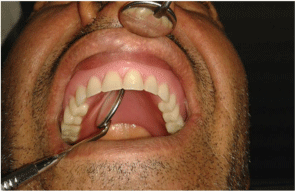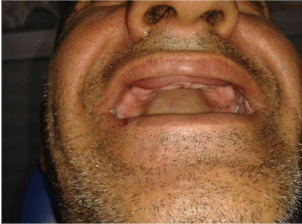
Case Report
J Dent App. 2015;2(2): 162-163.
Double Lip: A Case Report
Ali Ocak and Binali çakur*
Department of Oral Diagnosis and Oral Radiology, Faculty of Dentistry, Atatürk University, Erzurum, Turkey
*Corresponding author: çakur B, Department of Oral Diagnosis and Radiology, Faculty of Dentistry, Ataturk University, 25240, Erzurum / TURKEY
Received: December 03, 2014; Accepted: January 20, 2015;Published: January 22, 2015
Abstract
Double lip is an infrequently anomaly of the lip. Double lip is caused by excessive areolar tissue and non-inflammatory labial mucous gland hyperplasia of the pars villosa. The excess tissue interferes with mastication, speech or esthetic concern to the patient. This paper reports a case of congenital double upper lip in a 61–year-old male patient with the clinical features. A 61–year-old male patient was referred to our clinic for main complaint of ineffective retentive and unstable removal upper total prosthesis. During the course of examination, we saw a fold on upper lip when the mouth opened and it was become more prominent on smiling. This rare case should be considered for removal denture stabilization especially in patients who use total or partial denture.
Keywords: Double lip; Lip anomaly; Congenital; Acquired
Introduction
Double lip is an uncommon anomaly of the lip that more commonly occurring on the upper lip [1]. Double lip is caused by excessive areolar tissue and non-inflammatory labial mucous gland hyperplasia of the pars villosa [1]. It usually occurs two masses of hyper plastic tissue on either side of midline but may be unilaterally and can affect upper and lower lips [1]. Clinically, the double lip has a horizontal fold located between the inner (pars villosa) and the outer (pars glabrosa) parts of the lip. Depending on the increasing tensions double lip become more prominent when orbicularis oris muscle contracts during smiling, chewing or speaking [1]. It may be congenital or acquired and can affect both genders equally without race and gender predilection. But Palma and Taub [2] have suggested that there is a male gender predilection of 7:1 for this anomaly in their report in 2009. Double upper lip may be an isolated anomaly or it may occur in association with the changes that blepharochalasis and non-toxic thyroid enlargement in Ascher syndrome [3]. Parmar and Muranjan [4] described a patient with double upper and lower lips, unilateral eyelid ptosis, hypertelorism, blepharophimosis, broad nose with broad nasal tip, and bilateral third finger clinodactyly, and high arched palate and suggested that it was a new syndrome which is different from Ascher syndrome. Costa-Hanemann et al. [5] described a case of double upper lip associated with hemangiomas and enlargement of thyroid gland. Double lip has also been described in association with these abnormalities: bifid uvula, cleft palate, chellitis glandularis and hemangiomas. Double lip may be present at birth but it may not become more prominent until eruption of the permanent teeth [6]. The acquired double lip may develop secondary to trauma or in association with ascher’s syndrome [7]. Oral habits may also cause acquired double lip such as pulling the lip between diastema or between ill-fitting dentures [1,7]. Double lip may require surgical correction for cosmetic and functional reasons.
Case Report
A 61–year-old male patient was referred to our clinic for main complaint of ineffective retentive and unstable removal upper total prosthesis .The patient did not mention any other significant medical history. The patient has a full upper denture (Figure 1). Clinically examination revealed a mouth opening within normal limits and with no facial asymmetry. During the course of examination we saw a fold on upper lip when the mouth opened and it was become more prominent on smiling (Figure 2). There was no a family history of double lip or history of trauma or surgery. The patient said that double lip had been present since the period of youth that had the permanent teeth. He had no pain or parafunctional oral habits. There were not any other associated congenital abnormalities. There was no blepharochalasis and thyroid enlargement or unilateral eyelid ptosis, hypertelorism, blepharophimosis, broad nose with broad nasal tip, bilateral third finger clinodactyly, high arched palate symptoms related other syndrome. The patient was aware of double lip but he was not bothered enough for surgical correction. A provisional diagnosis of congenital double upper lip was made. Our patient was referred to surgery clinic for evaluation in terms of surgical stabilization of the prosthesis. However, the patient didn’t accept surgical procedure.

Figure 1: Double upper lip with denture.

Figure 2: Double upper lip can be seen when the lip tensed.
Discussion
Dentistry is important for the first recognition and diagnosis of double lip. Double lip is a rare developmental anomaly but the incidence of acquired or congenital double lip is probably much higher than reported in the literature. Double lip can affect both genders equally without race and gender predilection but some authors have suggested a potential hereditary character of the condition and a male gender predilection [2]. Our case was male as Palma and Taub mentioned. Double lip may be either a congenital abnormality or an acquired deformity. Congenital double lip usually involves the upper lip and it may not be noticed until permanent teeth eruption and the patient’s growth. In our case, there was a 61 year-old male patient who had no trauma or association with any syndrome so that congenital double upper lip was diagnosed. The congenital form of double lip is thought to occur during the second or third month of gestation from a persistence of the sulcus between the pars glabrosa and the pars villosa of the lip [1] .Double lip usually occurs on upper lip bilaterally but it may be unilaterally and on both lips. The acquired form of double lip may be secondary to trauma or oral habits therefore acquired double lip may occur unilaterally. In our case the patient has a bilaterally upper double lip since the patient’s youth. Reddy and Rao [8] have stated that the buccal portion appeared as two mucosal bulges on either side with a central constriction which was a constant feature in their 7 cases of congenital double upper lip. However there was a relatively central constriction in our case. There is no symptom when the upper lip is at rest, but the redundant tissue appears beyond the vermilion border of the lip when the upper lip is tensed as when smiling or talking. It was suggested that the mucosal bulge is composed of hypertrophied sub mucosal glands [7,8]. According to Converse et al., the anatomy of the orbicularis oris muscle is normal and no muscle fibers are available in the double lip [9]. In the fetus, the mucosa of the lip is divided into two zones: an outer part (pars glabrosa) that is smooth and similar to skin, and an inner part (pars villosa) that is similar to the oral mucosa. A double lip (which is the result of hypertrophy of the pars villosa) is thought to result from an exaggerated horizontal sulcus between the pars glabrosa and the pars villosa during the development of the lips [8]. Congenital double lip can problem for removal denture stabilization at edentulous jaws because of the excess tissue adhered to prosthesis [2]. In our case, there was a denture stabilization problem.
Double lip may correct in surgical for cosmetic and functional reasons. Treatment should be carried out by an intraoral excision of the mucosa and sub mucosal tissue, without involvement of the underlying muscle [1]. Some surgical techniques have been described to repair double lip: W-plasty, electrosurgical excision, triangular excision and transverse elliptical excision [1].
In our case, the double lip patient was not enough discomfort to justify surgical treatment. Acquired double lip has been reported to recur after surgery, but this has not been observed with the congenital double lip. The differential diagnosis of the double lip should be done with hemangioma, lymphangioma, angioedema, chellitis glandularis, mucosele, inflammatory fibrous hyperplasia, vascular tumour, cheilitis granulomatosis, salivary gland tumours, sardoidosis and plasma cell cheilitis [10].
Conclusion
This rare case should be considered especially in patients who use total or partial denture.
References
- Martins WD, Westphalen FH, Sandrin R, Campagnoli E. Congenital Maxillary Double Lip: Review of the literature and Report of a Case. J Can Dent Assoc 2004; 70: 466-468.
- Palma MC, Taub DI. Recurrent double lip: literature review and report of a case. Oral Surg Oral Med Oral Pathol Oral Radiol Endod 2009;107: e20-e23.
- Daniels JS. Congenital double upper lip: A case report and review of the literature. Saudi Dent J 2010; 22: 101-106.
- Parmar RC, Muranjan MN A newly recognized syndrome with double upper and lower lip, hyperthelorism, eyelid ptosis, blepharophimosis, and third finger clinodactyly. Am J Med Genet 2004; 124: 200-201.
- Costa-Hanemann JA, Tostes-Oliveira D, Fernandez-Gomes M, Silvados JD, Anjos M, et al. Congenital double lip associated to hemangiomas: report of a case. Med Oral 2004; 9: 155-158.
- Eski M, Nisanci M, Aktas A, Sengezer M. Congenitaldouble lip: review of 5 cases. Br J Oral Maxillofac Surg 2007; 45: 68-70.
- Alkan A, Metin M. Maxillary double upper lip: report of two cases. J Oral Sci 2001; 43: 69-72.
- Reddy KA, Rao AK. Congenital double lip: a review of seven cases. Plastic Reconstruc Surg 1989; 84: 420-423.
- Converse JM, Wood-Smith D, Macomber WB, Wang MKH. Reconstructive Plastic Surgery. 2nd ed, Philadelphia, Saunders 1977; 1543.
- Wood NK, Goaz PW. Differential diagnosis of oral lesions. St. Louis, Mosby 1985; 162-169.